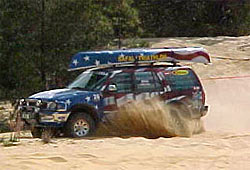|
TRS Tech Library Side Menu
|
This
article appeared on tennesseeoffroad.com, but is no longer available. It
has been found at the Internet Archive
and has been preserved here.
|
HILLS
|
 Bob
Yarborough - Stagecoach - Monteagle, TN
Bob
Yarborough - Stagecoach - Monteagle, TN
|

Dan Moses - Stagecoach - Monteagle,
TN
|
|
Hills
are one of the most dangerous obstacles in four wheeling. Hills
have claimed many vehicles over the years. Most people will
attempt to climb small, steep inclines, but not many go for the
super long and steep hills. Those that try the long hill climbs
and are successful, know the limitations of their vehicles and
are experienced drivers. If you feel uncomfortable about
climbing up a hill, don't try it.
-
When
driving up or down a hill, always try to go straight. If you
start going at an angle, it might cause the vehicle to start
the rolling process.
- Keep
your wheels on the ground at all times. As stated earlier, the
more your vehicle bounces, the greater chance it has to break
parts, important parts.
- When
going up a hill, the best type of soil condition is damp soil.
It offers you a lot better traction than muddy, dry, or loose.
Muddy, dry and loose cause the vehicle's tires to spin out and
loose traction.
- When
approaching the top of a hill, make sure you know what is on
the other side and ease up on the gas. You don't want to go
flying over the hill and end up in some crazy position.
- You
should apply the most power to your vehicle when you start
going up the hill. This gives you more momentum for the ride
up.
- When
you are going down a hill, keep your foot near the brake
pedal. If you need to use your brakes, use them lightly, too
hard will cause your wheels to lock up and you could start
sliding. If you start to slide, remember the rules of snow and
ice, turn in the direction that you are sliding.
- Always
use low gearing when driving down a steep hill.
|
|
Mud
|
 Rob
Matzell - Sarari Triathlon
Rob
Matzell - Sarari Triathlon
|

Dave Cagle - Coppenger Cove -
Monteagle, TN
|
|
- ALWAYS
know what kind of mud you are going through. Be sure that you
know how deep the mud hole is and if there are and rocks or
logs at the bottom (tire poppers). On some trail rides,
vehicles have gone into a mud hole and come out with a busted
tire because they did not know about the rocks at the bottom.
- While
going through a mud hole, turn your steering wheel back and
forth so the tires can find traction.
- If
you happen to get stuck, try backing up and going forward
again. If this doesn't help, try backing out of the hole.
Spinning your tires will only make the hole deeper and you
will find yourself in deeper mud than when you entered the
hole.
- A
word to the wise: If you see tracks going into a mud hole and
don't see them on the other side, think again.
|
|
Sand
|
 Michael
Wolf - Safari Triathlon
Michael
Wolf - Safari Triathlon
|

Brandon Russell - Safari Triathlon
|
|
- When
driving on sandy trails or open desert, make sure that you
have good steady speed.
- Use
four-high when driving in the sand.
- It
is a good idea to air down your tires as well. Use should
usually have them between 8 and 10 lbs of pressure.
- If
you happen to get stuck, there are a few things you might try.
The first one is wetting the sand around you to give you more
traction. You might also want to place your floor mats under
the tires for traction. You can also try digging out around
the tires and placing an object under your tires. If you don't
have either one of the things, try using a Pull-Pal or other
winching device. If all else fails, radio or call for help.
|
|
Ruts
|
 Mark
Lloyd - Tellico, NC
Mark
Lloyd - Tellico, NC
|
Ruts
can very tricky on the trails. Some trail conditions make it
where you have to drive down the side of a rut, straddle the rut
and then end up in it, or even one that you cannot get out of.
-
When
you see that the trail ahead of you is a big rut and you're
sure that you will end up in it, try and straddle it. If it
starts to get wider, ease down into it. Keep your vehicle
level and try to ride the sides of the rut with the sides of
your tires or sidewalls.
- Make
sure you have a spotter to guide you through the rut.
Remember, even if you know the trail like the back of your
hand, trails are always changing and eroding.
- Keep
your vehicle centered and level as possible while in a rut
when possible.
|
|